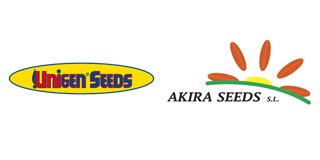
UNIGEN SEEDS SPAIN
The vapour heat treatment was an effective sanitation treatment for whole fresh cantaloupe melons, but caused injury to the peel
Harmful microorganisms can contaminate fresh fruits and vegetables and have caused outbreaks of foodborne illness. Therefore, mitigation strategies are needed to eliminate or restrict the multiplication of potential pathogens while maintaining fresh produce quality. This study assessed a vapour heat treatment on the control of Listeria on whole fresh cantaloupes (Cucumis melo)
26 November, 2020
Harmful microorganisms can contaminate fresh fruits and vegetables and have caused outbreaks of foodborne illness. Therefore, mitigation strategies are needed to eliminate or restrict the multiplication of potential pathogens while maintaining fresh produce quality. This study assessed a vapour heat treatment on the control of Listeria on whole fresh cantaloupes (Cucumis melo) and its impact on fruit physiology, composition and quality. Using a mixture of 4 strains of Listeria innocua, a non-pathogenic surrogate of Listeria monocytogenes, artificially contaminated cantaloupe were treated with 84?C vapour heat for 4 min, followed by storage at 4, 7 or 10?C for 0, 7, 10 or 14 days, respectively. At these times, fruit were analyzed for respiration rate, fruit volatile production, soluble solids, titratable acidity, flesh colour, firmness and visual appearance.On average, heat treatment achieved 4 log reductions in surrogate pathogen densities. However, changes invisual quality of whole fruit occurred that were influenced by storage temperature and duration, but independent of Listeria presence. Fruit respiration measured after warming fruit to 20?C was reduced in heat-treated fruit throughout storage,averaging 16.2 compared to 38.2 mg CO2/kg h for non-heated fruit suggesting permanent physiological damage occurred to the peel tissue. Heat treatments had variable effects on stress induced volatiles. Heat treatments reduced acetaldehyde, had no effect on ethanol and increased ethyl acetate emissions. Storage at 10?C stimulated the emission of all three volatiles. Heat-treated melons had greater emissions of acetate and reduced emissions of butanoate esters. No discoloration or deterioration of flesh tissue was noted immediately after heat treatment, nor was flesh firmness, soluble solids or titratable acids significantly altered by heat treatment. The vapour heat treatment was an effective sanitation treatment, but caused injury to the melon peel. Therefore, this treatment could be used to ensure safety of fresh-cut melon products. Original title, list of authors and sourceImpact of heat sanitation of fresh whole cantaloupe on fruit quality and volatile metabolismC.F. Forney, G.S. Bezanson, T.C. Ells, L. Fan, D.I. LeBlancAtlantic Food & Horticulture Research Centre, Agriculture & Agri-Food Canada, Kentville, Nova Scotia, CanadaV Postharvest Unlimited, ISHS International Conference, 10-13 June 2014, Cyprus, http://web.cut.ac.cy/postharvest/ ? Key wordsPoscosecha?? ?postcosecha?? ?postharvest?? ?na-oes?? ??? ??? ???????? ????? ??? ?post-r?colte?? ????? ?? ??????????? ??? ?na-oogst?? ?post-raccolta?? ?Obr?bka po?? ?p?s-colheita?? ????????????????? ?hasat sonras??? ??? ?Ernte?? ????????????????? ????? ????????????? ?postcollita?? ?poskliz?ov頠 ????? ??? ??? ??? ?nakon branja?? ?pozberov頠 ??? ?obdelovanje zemlje po?? ?post-colleita?? ?????? ??????? ?pascapanen?? ??il?onn postharvest?? ??????? ?p?c ra?as?? ?derliaus apdirbimas po?? ?lepas tuai?? ??? ?? ???????? ?post-recoltare?? ??????? ??????? ???????????????????? ?????????????? ?????????????????? ?sau thu ho?ch?? ?????????????????? ?zangemva kwenkathi yokuvunaMel?n?? ??? ?melon?? ?waatlemoen?? ??????? ???? ?melono?? ??? ????????? ???????? ?meloen?? ?melone?? ??? ??? mel?o?? ??????? ?kavun?? ???????? ??? ??? ??? ??? ??? ??? ??? ??? ??? ??? ??? ??? ??? ??? ??? ??? ??? ??? ??? ??? ??? ??? ??? ??? ??? ??? ??? ???? ?









